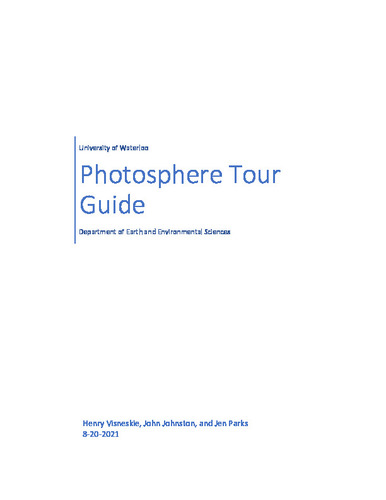| dc.contributor.author | Visneskie, Henry | |
| dc.contributor.author | Johnston, John | |
| dc.contributor.author | Parks, Jen | |
| dc.date.accessioned | 2022-06-07 20:41:22 (GMT) | |
| dc.date.available | 2022-06-07 20:41:22 (GMT) | |
| dc.date.issued | 2021-08-20 | |
| dc.identifier.uri | http://hdl.handle.net/10012/18358 | |
| dc.description | Special thanks to Dr. Bob Lemieux and the Dean of Science Undergraduate Teaching Initiative at the University of Waterloo for funding our project titled “Using emerging technologies to enhance field, experiential and active based learning in Earth and Environmental Sciences”. These funds helped hire Henry as a co-op Emerging Technologies Research Assistant and purchase simple, virtual reality equipment to experiment with VR in geoscience classes and labs. This helped form the basis for Henry’s BSc thesis, in UWSpace, referenced above. A special thank you to the many people that provided professional support and expertise for this funded project (initiating an undergraduate thesis, presented at conferences and creation of videos posted on YouTube) from the University of Waterloo’s VR/AR Community of Practice, Centre for Extended Learning, Centre for Teaching Excellence and Library. Also to the Oil, Gas, and Salt Resource Library, Ontario Geological Survey and Geological Survey of Canada. | en |
| dc.description.abstract | This document serves as a comprehensive guide for creating and implementing Virtual Reality (VR) into education at the post-secondary level, as well as recommendations for integrating course learning objectives in Virtual Tours. Virtual Tours are assemblies of 360° photospheres and/or panoramas that transition the viewer through a series of 360° environments, which can be static or active (depending on the hardware and software used to capture the environments and construct the Tours). Virtual Tours are an appealing medium for educators to explore due to their inherently immersive and engaging nature as well as their inexpensive entry point to create. They also offer many customisation options to accommodate a wide variety of students, instructors and intended learning outcomes. This document describes the process of creating Virtual Tours using the now discontinued free Google Tour Creator (creation) and Google Poly (viewing) websites as well as the Google Expeditions mobile app. While no longer supported by Google’s software, this document offers valuable insight into the design of Virtual Tours that are pedagogically effective for student learning and the next generation of Google Tours (i.e. Google Expedition Pro). This document elaborates on the purpose of specific design choices that can be made in a Virtual Tour creation platform that help support student learning. | en |
| dc.language.iso | en | en |
| dc.publisher | University of Waterloo | en |
| dc.rights | Attribution 4.0 International | * |
| dc.rights.uri | http://creativecommons.org/licenses/by/4.0/ | * |
| dc.subject | photospheres | en |
| dc.subject | vr | en |
| dc.subject | virtual reality | en |
| dc.subject | vr guide | en |
| dc.subject | education | en |
| dc.subject | xr | en |
| dc.subject | google tour creator | en |
| dc.subject | google poly | en |
| dc.subject | pedagogy | en |
| dc.subject | google expeditions kit | en |
| dc.title | Photosphere Tour Guide | en |
| dc.type | Technical Report | en |
| dcterms.bibliographicCitation | Visneskie, H., Johnston, J., Parks, J. (2021). Photosphere Tour Guide. Department of Earth and Environmental Sciences, University of Waterloo | en |
| uws.contributor.affiliation1 | Faculty of Science | en |
| uws.contributor.affiliation2 | Earth and Environmental Sciences | en |
| uws.typeOfResource | Text | en |
| uws.peerReviewStatus | Unreviewed | en |
| uws.scholarLevel | Faculty | en |


